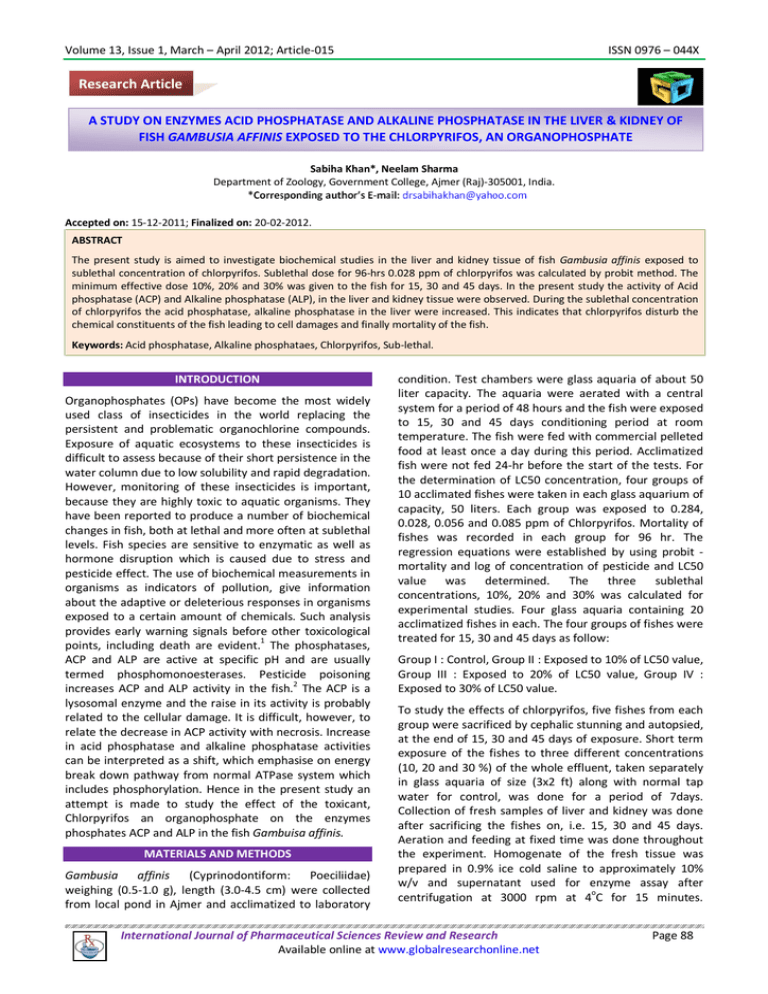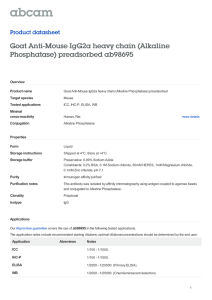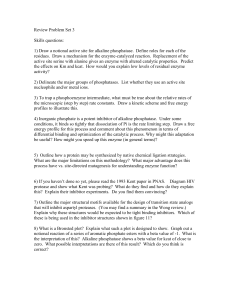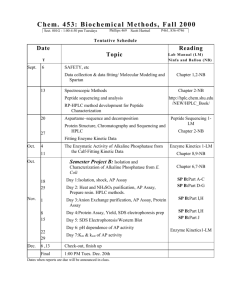Document 13308720
advertisement

Volume 13, Issue 1, March – April 2012; Article-015 ISSN 0976 – 044X Research Article A STUDY ON ENZYMES ACID PHOSPHATASE AND ALKALINE PHOSPHATASE IN THE LIVER & KIDNEY OF FISH GAMBUSIA AFFINIS EXPOSED TO THE CHLORPYRIFOS, AN ORGANOPHOSPHATE Sabiha Khan*, Neelam Sharma Department of Zoology, Government College, Ajmer (Raj)-305001, India. Accepted on: 15-12-2011; Finalized on: 20-02-2012. ABSTRACT The present study is aimed to investigate biochemical studies in the liver and kidney tissue of fish Gambusia affinis exposed to sublethal concentration of chlorpyrifos. Sublethal dose for 96-hrs 0.028 ppm of chlorpyrifos was calculated by probit method. The minimum effective dose 10%, 20% and 30% was given to the fish for 15, 30 and 45 days. In the present study the activity of Acid phosphatase (ACP) and Alkaline phosphatase (ALP), in the liver and kidney tissue were observed. During the sublethal concentration of chlorpyrifos the acid phosphatase, alkaline phosphatase in the liver were increased. This indicates that chlorpyrifos disturb the chemical constituents of the fish leading to cell damages and finally mortality of the fish. Keywords: Acid phosphatase, Alkaline phosphataes, Chlorpyrifos, Sub-lethal. INTRODUCTION Organophosphates (OPs) have become the most widely used class of insecticides in the world replacing the persistent and problematic organochlorine compounds. Exposure of aquatic ecosystems to these insecticides is difficult to assess because of their short persistence in the water column due to low solubility and rapid degradation. However, monitoring of these insecticides is important, because they are highly toxic to aquatic organisms. They have been reported to produce a number of biochemical changes in fish, both at lethal and more often at sublethal levels. Fish species are sensitive to enzymatic as well as hormone disruption which is caused due to stress and pesticide effect. The use of biochemical measurements in organisms as indicators of pollution, give information about the adaptive or deleterious responses in organisms exposed to a certain amount of chemicals. Such analysis provides early warning signals before other toxicological points, including death are evident.1 The phosphatases, ACP and ALP are active at specific pH and are usually termed phosphomonoesterases. Pesticide poisoning 2 increases ACP and ALP activity in the fish. The ACP is a lysosomal enzyme and the raise in its activity is probably related to the cellular damage. It is difficult, however, to relate the decrease in ACP activity with necrosis. Increase in acid phosphatase and alkaline phosphatase activities can be interpreted as a shift, which emphasise on energy break down pathway from normal ATPase system which includes phosphorylation. Hence in the present study an attempt is made to study the effect of the toxicant, Chlorpyrifos an organophosphate on the enzymes phosphates ACP and ALP in the fish Gambuisa affinis. MATERIALS AND METHODS Gambusia affinis (Cyprinodontiform: Poeciliidae) weighing (0.5-1.0 g), length (3.0-4.5 cm) were collected from local pond in Ajmer and acclimatized to laboratory condition. Test chambers were glass aquaria of about 50 liter capacity. The aquaria were aerated with a central system for a period of 48 hours and the fish were exposed to 15, 30 and 45 days conditioning period at room temperature. The fish were fed with commercial pelleted food at least once a day during this period. Acclimatized fish were not fed 24-hr before the start of the tests. For the determination of LC50 concentration, four groups of 10 acclimated fishes were taken in each glass aquarium of capacity, 50 liters. Each group was exposed to 0.284, 0.028, 0.056 and 0.085 ppm of Chlorpyrifos. Mortality of fishes was recorded in each group for 96 hr. The regression equations were established by using probit mortality and log of concentration of pesticide and LC50 value was determined. The three sublethal concentrations, 10%, 20% and 30% was calculated for experimental studies. Four glass aquaria containing 20 acclimatized fishes in each. The four groups of fishes were treated for 15, 30 and 45 days as follow: Group I : Control, Group II : Exposed to 10% of LC50 value, Group III : Exposed to 20% of LC50 value, Group IV : Exposed to 30% of LC50 value. To study the effects of chlorpyrifos, five fishes from each group were sacrificed by cephalic stunning and autopsied, at the end of 15, 30 and 45 days of exposure. Short term exposure of the fishes to three different concentrations (10, 20 and 30 %) of the whole effluent, taken separately in glass aquaria of size (3x2 ft) along with normal tap water for control, was done for a period of 7days. Collection of fresh samples of liver and kidney was done after sacrificing the fishes on, i.e. 15, 30 and 45 days. Aeration and feeding at fixed time was done throughout the experiment. Homogenate of the fresh tissue was prepared in 0.9% ice cold saline to approximately 10% w/v and supernatant used for enzyme assay after centrifugation at 3000 rpm at 4oC for 15 minutes. International Journal of Pharmaceutical Sciences Review and Research Available online at www.globalresearchonline.net Page 88 Volume 13, Issue 1, March – April 2012; Article-015 ISSN 0976 – 044X Estimation of alkaline and acid phosphatases was done by the U.V. Kinetics method.3,4 (0.085 ppm) were calculated for experimental purposes. Biochemical estimations of Alkaline and acid phosphatases in liver and kidney of control as well as in test Gambusia affinis were done. The results are as follows: Observation Mortality studies showed that the sublethal level, LC50 of Gambusia affinis for 96 hr. exposure was 0.284 ppm for Chlorpyrifos. The minimum effective doses 10% of LC50 (0.028 ppm), 20% of LC50 (0.056 ppm) and 30% of LC50 Values are expressed mean ± SE of observations Values are significant at x P<0.05, y P<0.01, z P<0.001. Table 1: Changes in Alkaline and Acid phosphatases in liver of Gambusia affinis during control and post-treatment with Chlorpyrifos insecticide. Organ Liver Duration of Exposure (Days) ALP 15 8.02±0.018 30 x 45 E10 (Effluent 10%) Control ACP 8.35±0.03 8.69±0.018 x x ALP 4.52±0.018 x 5.43±0.027 x 6.18±0.012 y 9.31±0.015 x 9.40±0.013 x 9.54±0.011 y E20 (Effluent 20%) ACP ALP 7.41±0.018 10.28±0.01 y 10.36±0.02 x 7.52±0.012 x E30 (Effluent 30%) ACP x 7.88±0.018 10.83±0.011 ALP 8.64±0.014 y 8.87±0.018 x y 8.96±0.02 x ACP 11.41±0.028 x 9.17±0.023 x 11.45±0.018 x 9.32±0.016 x 11.79±0.015 y 9.67±0.011 x Results expressed in (mg pi/g/h) (Mean ± SD). Table 2: Changes in Alkaline and Acid phosphatases in kidney of Gambusia affinis during control and post-treatment with Chlorpyrifos insecticide. Organ Kidney Duration of Exposure (Days) ALP 15 5.62±0.011 x 6.75±0.013 x 30 45 E10 (Effluent 10%) Control ACP 7.28±0.025 ALP 4.06±0.018 z 5.33±0.019 x 6.11±0.015 x E20 (Effluent 20%) ACP 6.35±0.015 z 7.23±0.011 x 8.53±0.012 x ALP 5.69±0.018 x 6.14±0.011 x 7.12±0.016 z E30 (Effluent 30%) ACP 7.14±0.008 y 8.69±0.018 x 9.34±0.015 x ALP 6.37±0.021 z 7.27±0.015 x 8.24±0.011 x ACP 8.02±0.013 y 7.58±0.015 x 9.13±0.011 x 8.34±0.018 y 9.15±0.022 x 10.08±0.018 x Results expressed in (mg pi/g/h) (Mean ± SD). Figure 1: Changes in the specific activity levels of Alkaline Phosphatase in target tissues liver & kidney of Gambusia affinis on exposure to sublethal concentration of chlorpyrifos of 10, 20 and 30 % EC formulation for 15, 30 & 45 days. Figure 2: Changes in the specific activity levels of Acid Phosphatase in target tissues liver & kidney of Gambusia affinis on exposure to sublethal concentration of chlorpyrifos of 10, 20 and 30 % EC formulation for 15, 30 & 45. RESULTS AND DISCUSSION Increase in acid and alkaline phosphatases activity can be interpreted as a shift of the tissue emphasis on energy break down path way from normal ATPase system to phosphatase system. Pesticides reduce glycogen levels and increase phosphorylase activities. In the event of decreased ATPase system, phosphorylation may be preceded by activated phosphatases to catalyse the liberation of inorganic phosphatases form phosphate esters. The increase in the liver alkaline phosphatase induced by different insecticides has also been reported by many workers.5-7 Exposure to sublethal doses of Nerium indicum latex extract in ethanol NLEtOH for 24 and 96 h exposure period caused significant reduction in total protein, nucleic acids (DNA and RNA), glycogen, pyruvate level, enzyme AChE, LDH, SDH, CyO activities and also caused significant enhancement in total free aminoacids, lactate level, enzyme proteases, ALAT, AAT activity in both liver and muscle tissues of Colisa fasciatus (weed fish). Seven days withdrawal experiment showed significant recovery in all the above biochemical parameters in both the tissues of the fish.8 I.R. Inyang et. al reported that phosphatase levels the plasma do not represent good indices of the effect of diazinon in C. 9 gariepinus. However, the activities of ALP and ACP in the organs (GIT, kidney, muscle, gill and liver) of C. gariepinus potentiate useful bio-indictors in the Niger Delta environment with respect to the sub-lethal effects of organophosphate pesticides in fish. For costeffectiveness, monitoring programmes could include ACP and ALP levels in muscle and/or gills of C. gariepinus. Elevation in alkaline phosphatase activity might be due to an accelerated membrane transport function related to anion hydroxide exchange across the lipid biomembranes mediated by organotin compounds. Another possibility for the increase in the activity of alkaline phosphatase may be the destruction of the hepatic smooth International Journal of Pharmaceutical Sciences Review and Research Available online at www.globalresearchonline.net Page 89 Volume 13, Issue 1, March – April 2012; Article-015 ISSN 0976 – 044X 10 endoplasmic reticulum membrane in the insecticide intoxicated mice as supported by pathological observations made in the hepatic tissue of intoxicated fish. This increase in the hepatic alkaline phosphatase activity was due to the cellular damages caused by hepatotoxins or a response to overcome toxicity of chlorpyrifos. Acid phosphatases are hydrolytic lysosomal enzymes and are released by the lysosomes for the hydrolysis of foreign material, hence it has a role in certain detoxification functions. It is known as inducible enzyme whose activity in animal tissue goes up when there is a toxic impact and the enzyme being to counteract. Subsequently the enzyme activity may begin to drop either as a result of having partly or fully encountered the toxin or as a result of cell damage. The increase in hepatic acid phosphatase activity in intoxicated animals as observed in the present investigation may be due to the destruction of the lysosomal membrane which resulted in the release of the enzyme. Jyothi and Narayan exposed the fresh water edible cat fish Clarias batracus (Linn.) to sublethal concentrations of two different groups of pesticidescarbaryl, a carbamate and phorate, an organophosphorus pesticide for 24, 74, 120 and 168 hours. They notified the increased level of alkaline phosphatase.11 Verma et al., identified the elevation of three phosphatases namely acid, alkaline and glucose-6-phosphatase in the serum of Mystus vittatus on exposure to the effects of pesticides thiotox, dichlorvos, carbofuran and their three combinations. Elevation, in alkaline phosphatase was more than acid and glucose-6-phosphatases.12 CONCLUSION An increase in the acid phosphatase activity in liver and kidney, while there was no significant change in the activity of alkaline phosphatase in kidney and in liver tissue, the enzyme was inhibited. This is in conformity with the present study. Pesticide poisoning altered the activity of ACP and ALP. Acid phosphatase activity of liver of Gambusia affinis increased in all the three doses increase in protease activity may be due to the damage caused to the lysosomal membrane, thus permitting the leakage of lysosomal enzyme into cytosol. It is found that Chlorpyrifos disturb the chemical constituents of the fish which leads to cell damages and finally death of fishes. REFERENCES 1. Livingstone, D.R. The fate of organic xenobioticos in aquatic ecosystems: quantitative and qualitative differences in biotransformation by invertebrates and fish. Comparative Biochem. And physio. 120, 1998, 43-49. 2. Tejendra, S.G., Jaishree, P. and Tiwari, H. Enzyme modulation by sublethal concentrations of aldicarb, phosphamidon and endosulfan in fish tissues. Pestic. Biochem. Physiol. 38, 1990, 231-244. 3. Kinetic method for quantitative determination of acid phosphatase and prostatic phosphatase (P ACP) activity [EC 3.1.2] in human serum. www.biolabo.fr, Version: AT 82560 25 09 2008. 4. Kinetic method for quantitative determination of alkaline phosphatsase activity [EC 3.1.3.1] in human serum and plasma. www.biolabo.fr, Version: AT 92214 11 07 2008. 5. Joshi U. M. and Desai A. K. Effect of sublethal concentration of monocrotophos on acid and alkaline phosphatase activities in the tissue of freshwater fish, Tilapia mossambica. J. Anim. Morphol. Physiol. 28, 1981, 221-228. 6. Kumar R. and Kumar R. Ammonia induced toxicity to phosphatases in an airbreathing teleost, Channa punctatus (Bloch). Ad. Bios. 16, 1997, 19-28. 7. Singh S. P. and Singh R. Some histochemical changes in the liver of carbontetrachloride treated bat, Rhinopoma microphyllum. Ad. Bios. 21, 2002, 17-22. 8. Tiwari, S. and Singh, A. Changes in some biochemical parameters in the liver and muscle of Colisa fasciatus due to toxicity of ethanolic extract of Nerium indicum Mill. (Lal Kaner/Latex). Natural Product Radiance, 8(1), 2009, 48-54. 9. Inyang, I.R., Daka, E.R. and Ogamba, E.N. Effect of Diazinon on Acid and Alkaline Phosphatase Activities in Plasma and Organs of Clarias gariepinus, Current Research Journal of Biological Sciences 3(3), 2011, 191-194. 10. Khan S. and Pandya K. P. Hepatotoxicity in albino rats exposed to n-octane and n-nonane. J. Appl. Toxicol. 5, 1985, 63. 11. Jyothi, B. and Narayan, G. Certain pesticide – induced carbohydrate metabolic disorders in the serum of freshwater fish Clarias batrachus Linn. Food and chemical toxicology. 37: 1999, 417-421. 12. Verma, S.R. and Tonk, I.P. Biomonitoring of the contamination of water by a sublethal concentration of pesticides. A system analysis approach. ACTA Hydrochim Hydrobiol. 124, 1984, 399-499. ********************** International Journal of Pharmaceutical Sciences Review and Research Available online at www.globalresearchonline.net Page 90



![Anti-Human Kappa Chain antibody [SB81a] (Alkaline Phosphatase) ab79117](http://s2.studylib.net/store/data/012476374_1-16d075b4eb9fc2b5d64a638084cccac0-300x300.png)